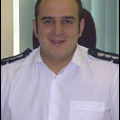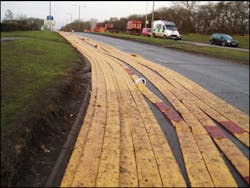Most people in Hemel Hempstead in Hertfordshire, England, expected that Dec. 11, 2005, was going to be a cold and clear late-autumn Sunday like any other. Families planned to put up their Christmas decorations, go into town to join the crowds in the inevitable Christmas shopping rush or just have an easy day at home.
That was all about to change at the Hertfordshire Oil Storage Terminal. Known as the Buncefield terminal, it is the fifth-largest oil storage terminal in the UK, holding up to 60 million gallons of oil, 5% of the UK’s capacity. It is a major hub on the UK fuel pipeline network and a major supplier of aviation fuel to Heathrow and Luton airports. The site is owned by Total UK Ltd. and supplies fuel to most of the gasoline stations in southeast England.
Just before 6:03 A.M., a skeleton staff was working at the site, as most of the operation is automated, and a few tanker drivers were on the site having or waiting to have their tankers filled before delivery. It has been reported that a large vapor cloud was seen approaching the loading area of the site. Those on the site were ordered to evacuate and as they did a massive explosion rocked the site.
Buildings in the immediate vicinity and in the adjacent industrial parks were blown apart. A massive fire started in the storage tank area known as HOSL West, behind the loading area, and many residents in the immediate area were literally blown from their beds by the force of the explosion. Houses in the surrounding square miles were moderately damaged with doors and windows being blown out. Those farther away suffered minor damage.
It is believed that the force of this explosion was the greatest in Europe since World War II. Due to a temperature inversion, where the air in the upper atmosphere is warmer than that on the ground, the explosion and subsequent smoke plume reached a certain height, then the waves were forced back down and out. This meant that many people clearly heard the explosion up to 50 miles away. In fact, it is claimed that people a couple of hundred miles away in Belgium and the Netherlands also heard it. (This theory has been investigated and, although very rare, the conditions were right for the explosion to be heard that far away). Amazingly, no one was killed and a relatively few people were injured. There were 43 recorded injuries and only two of them were serious.
Within seconds, multiple calls were being received by Hertfordshire Fire Control Officers (dispatch), who at the time only had four people on duty. Local apparatus were dispatched to the scene, but it was already evident from the explosion that a major incident was underway.
The initial fire spread throughout the western part of the site; tanks holding gasoline, aviation fuel and oil were soon involved. Two more explosions rocked the site at 6:28 as additional tanks became involved.
The Hertfordshire Fire Brigade is a county fire department just north of London. With 32 stations, some with full-time staffing and some with part-time crews, and even with every single resource at their disposal at that moment, it was evident to chief officers that the incident was going to have to be tackled in terms of days instead of hours with the biggest collaboration of UK fire service resources pooled together since the war.
Due to the temperature inversion, the giant smoke plume hit 9, 000 feet and then began to fan out to the south. Before long, and again for the first time since the Blitz, London’s winter sun was blotted out by smoke. The smoke cloud was so vast it appeared as a large black smudge covering a large part of southern England on satellite images taken from space.
One lesson learned during World War II was the importance of a degree of standardization of firefighting equipment, procedures and training across the nation. At this incident, one thing was certain: every piece of equipment, every procedure and every bit of terminology used by all the crews there – whether from the local county, from London or from the other rural counties – was common. London firefighters responding to a separate incident in Hertfordshire while the local crew was at the oil depot knew that they could get water from a standard fire hydrant.
A watch officer (lieutenant) in the Hertfordshire Fire Brigade, based at a station near Hemel Hempstead, said, "We were mobilized as part of the first attendance [response]. The first we knew that it was going to be a massive job was when control informed us enroute that this had been declared a major incident. Buncefield, as everyone in the Hertfordshire Fire Brigade knows, was one of our largest risks and I can remember sitting through many lectures on the subject as this was always a favorite for the old sub-officer’s examinations."
The watch officer continued, "We attended via the M25 [highway] and we could see from many miles away the thick, black plume of smoke that was already beginning to show. There is always a different kind of hush on the way to these jobs as you know, and the main scheme radio was turned on full to hear the informative and assistance messages coming in."
The first message the watch officer heard was from the sub-officer (lieutenant) of Hemel Hempstead’s first-due engine at 6:18 A.M.: "Major fire in tank farm of oil terminal. Approximately six people missing, numerous casualties reported. Efforts being made to contact site management. Redeployment of firefighting services, access for oncoming appliances [apparatus] via M1 motorway. Tactical mode Delta," meaning that the tactical mode for the fire was declared as defensive.
The watch officer said, "This definitely confirmed to us that this was the big one. As we pulled up to the rendezvous point, we were met by a station officer (captain) who advised us of our tasks. We were to follow the perimeter of the site to search for casualties in the surrounding buildings. There were many smaller fires in the surrounding areas. Cars that had been blown out of the car parks well alight, large trucks that belonged to surrounding businesses with all their windows blown out. The buildings surrounding the site had all their windows blown in, some buildings had completely collapsed and the trees were like matchsticks."
He continued, "I have never been in a war zone, but this is how I imagine it to be. We spoke amongst ourselves, all guessing how many fatalities we would find. If I had been told there were 200 fatalities in those buildings, I would have said that was a fair estimation. In one of the business parks, we had a four-story building heavily involved in fire. We radioed back to the control unit for four pumps [engines], an aerial truck and a chief. It was at this point I needed to ‘wake up’ – it was very real and I could speak for everyone in saying it all felt very surreal."
At this time, hoselines were being set up to provide covering sprays to the adjacent tanks not involved.
"Many more pieces of apparatus had arrived by now and it was clear at this stage that there would be no offensive firefighting, just a gathering of resources," the watch officer said. "We were relieved at around 11 A.M., only to return at 1800 that night."
In the meantime, the eyes of the world became focused on the site and it was clear that vast amounts of resources were going to be required. No single fire brigade had the stocks of foam concentrate required to deal with this incident. Soon, municipal and industrial fire brigades had foam stocks and foam-making equipment on the road to Hertfordshire.
The strategy that was adopted was as yet untried, but it was agreed that once enough foam concentrate had been gathered and sufficient water was being pumped to the site, each of the 25 tanks that were now on fire would be fought one by one, with cooling jets in place on the others at all times. As each fire was extinguished, the blanket of foam continued to be built up to gradually reduce the risk of re-ignition.
Throughout the operation, the determination of fire crews was being challenged. More than a few close calls occurred when burning tanks were compromised, causing massive running-fuel fires. One of these was so severe that an additional 25 engines and 125 firefighters were called just to deal with that.
It was also apparent that local water supplies had nowhere near the capacity to flow the required amount of water on to the fire. A request was made to the Office of the Deputy Prime Minister (ODPM) to facilitate the provision of water to the incident with the use of high-volume pumpers. The London Fire Brigade was given the job of facilitating the water supply using large-volume pumpers from surrounding counties and more-distant areas. Experts in the design and use of the high-volume pumpers were enlisted from the ODPM and The Fire Service College in Gloucestershire.
At 6 P.M., the watch officer and his crews went back to Hemel Hempstead.
"When we arrived at 18:45, we were instructed to work with the Essex crews in setting up their big foam monitors," he said. "We had five Herts appliances lifting from open water (a million-gallon reservoir), which would in turn be supplying water to 1,000-liter foam pods and then onto a large foam monitor."
The entire site was well involved. Firefighters were instructed to locate a suitable and sustainable water supply that was eventually used for the high-volume pumpers.
"At around 1 A.M., we were relieved," the watch officer said. "I noticed that there were many different brigades in attendance. Because our pump was tied down pumping, we had to take any appliance we could find. We ended up with a retained appliance from a station a good 40 miles from ours."
On Monday, it was clear that the Herts crews and the industrial firefighters were going to be doing the firefighting, with the other brigades taking care of supplies.
"My job on Monday was to supply foam from the foam pods that were being delivered from all over the country to industrial foam tender," the watch officer said. "What we did was to cut off the coupling from one end of hard suction, submerge it in the 1,000-liter foam pods, draw the concentrate into the major pump and supply the foam tender via all three outlets of the pump. The foam tender would then mix the concentrate with water, which would then supply the foam branches. We spent about eight hours doing that task."
The following days, the foam blankets continued to be applied to the area. Apart from a few small outbreaks where the foam blanket was compromised, there were no further dramas.
Twelve five-inch lines were deployed covering a total of 14 miles from surrounding water supplies to the depot from the hose modules of the high-volume pumpers. It has been estimated that without the use of the high-volume pumpers, the incident would have required 80 pumpers – 60 in a relay and 20 on the site to provide the water required to extinguish the fire. Fire crews remained on the scene for well over a week. A preliminary inquiry found that the explosion was caused by a vapor leak. A full investigation is being carried out by the UK’s Health & Safety Executive, which will report later this year.
Steve Dudeney is an assistant divisional officer (battalion chief) with the London Fire Brigade.
About the Author

